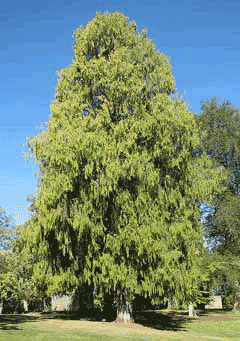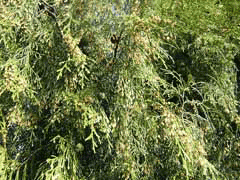 |
|
http://en.wikipedia.org/wiki/User:Melburnian |
 |
| http://commons.wikimedia.org/wiki/User:MPF |
Translate this page:
Summary
Physical Characteristics

 Cupressus funebris is an evergreen Tree growing to 25 m (82ft 0in).
Cupressus funebris is an evergreen Tree growing to 25 m (82ft 0in).
See above for USDA hardiness. It is hardy to UK zone 8. It is in leaf all year, in flower from April to May. The species is monoecious (individual flowers are either male or female, but both sexes can be found on the same plant) and is pollinated by Wind.
Suitable for: light (sandy), medium (loamy) and heavy (clay) soils, prefers well-drained soil and can grow in nutritionally poor soil. Suitable pH: mildly acid, neutral and basic (mildly alkaline) soils and can grow in very acid soils.
It cannot grow in the shade. It prefers dry or moist soil and can tolerate drought.
UK Hardiness Map
US Hardiness Map
Synonyms
Chamaecyparis funebris. (Endl.)Franco.
Plant Habitats
Woodland Garden Canopy;
Edible Uses
References More on Edible Uses
Medicinal Uses
Plants For A Future can not take any responsibility for any adverse effects from the use of plants. Always seek advice from a professional before using a plant medicinally.
Antiperiodic
The leaf is antiperiodic[218]. It is used in the treatment of bleeding piles, excessive menstrual flow etc[218]. A decoction of fruiting branches is used in the treatment of colds[218].
References More on Medicinal Uses
The Bookshop: Edible Plant Books
Our Latest books on Perennial Plants For Food Forests and Permaculture Gardens in paperback or digital formats.

Edible Tropical Plants
Food Forest Plants for Hotter Conditions: 250+ Plants For Tropical Food Forests & Permaculture Gardens.
More

Edible Temperate Plants
Plants for Your Food Forest: 500 Plants for Temperate Food Forests & Permaculture Gardens.
More

More Books
PFAF have eight books available in paperback and digital formats. Browse the shop for more information.
Shop Now
Other Uses
Wood
Wood - hard, tough, white, durable, close grained. Used for general construction, agricultural implements etc[61, 109].
Special Uses
Scented Plants
References More on Other Uses
Cultivation details
Thrives in a well-drained loamy or peaty soil[11]. Very tolerant of hot dry conditions[81]. Tolerates poor sandy soils[81] but is then more subject to insect damage in a succession of dry seasons[11]. Requires a sunny position[81]. Prefers a pH of 6 or lower[200]. Somewhat tender in Britain, at least in the north of the country[81], it also seems to be short-lived[185]. Plants do not succeed at Kew[11]. Cultivated as a timber crop in China[61]. Cones can remain closed on the tree for a number of years, opening after the heat of a forest fire to scatter their seeds which then germinate and grow rapidly in the ashes of the fire[200]. Plants are subject to injury by the wind[11, 81]. Trees are notably susceptible to honey fungus[200]. The crushed foliage has the scent of grass[185].
References Carbon Farming Information and Carbon Sequestration Information
Temperature Converter
Type a value in the Celsius field to convert the value to Fahrenheit:
Fahrenheit:
The PFAF Bookshop
Plants For A Future have a number of books available in paperback and digital form. Book titles include Edible Plants, Edible Perennials, Edible Trees,Edible Shrubs, Woodland Gardening, and Temperate Food Forest Plants. Our new book is Food Forest Plants For Hotter Conditions (Tropical and Sub-Tropical).
Shop Now
Plant Propagation
Seed - sow late winter in a cold frame and only just cover the seed[164]. Three weeks cold stratification can improve germination rates[164]. The seed usually germinates in 1 - 2 months at 20°c. The seedlings are very subject to damping off so should be watered with care and kept well-ventilated[113]. When they are large enough to handle, prick the seedlings out into individual pots and grow them on in the greenhouse for at least their first winter. Plant them out into their permanent positions in late spring or early summer, after the last expected frosts. The seed can store for several years[113]. Cuttings of almost ripe wood, September in a frost-proof frame[1]. April/May is the best time to take cuttings[113].
Other Names
If available other names are mentioned here
Native Range
TEMPERATE ASIA: China (Anhui Sheng, Fujian Sheng, Gansu Sheng, Guangdong Sheng (north), Guangxi Zhuangzu Zizhiqu (north), Guizhou Sheng (east), Henan Sheng, Hubei Sheng (west), Hunan Sheng, Jiangxi Sheng, Shaanxi Sheng, Sichuan Sheng, Yunnan Sheng, Zhejiang Sheng)
Weed Potential
Right plant wrong place. We are currently updating this section.
Please note that a plant may be invasive in one area but may not in your area so it's worth checking.
Conservation Status
IUCN Red List of Threatened Plants Status :

Growth: S = slow M = medium F = fast. Soil: L = light (sandy) M = medium H = heavy (clay). pH: A = acid N = neutral B = basic (alkaline). Shade: F = full shade S = semi-shade N = no shade. Moisture: D = dry M = Moist We = wet Wa = water.
Now available:
Food Forest Plants for Mediterranean Conditions
350+ Perennial Plants For Mediterranean and Drier Food Forests and Permaculture Gardens.
[Paperback and eBook]
This is the third in Plants For A Future's series of plant guides for food forests tailored to
specific climate zones. Following volumes on temperate and tropical ecosystems, this book focuses
on species suited to Mediterranean conditions—regions with hot, dry summers and cool, wet winters,
often facing the added challenge of climate change.
Read More
Expert comment
Author
Endl.
Botanical References
11200266
Links / References
For a list of references used on this page please go here
Readers comment
| Add a comment |
|
If you have important information about this plant that may help other users please add a comment or link below. Only comments or links that are felt to be directly relevant to a plant will be included. If you think a comment/link or information contained on this page is inaccurate or misleading we would welcome your feedback at [email protected]. If you have questions about a plant please use the Forum on this website as we do not have the resources to answer questions ourselves.
* Please note: the comments by website users are not necessarily those held by PFAF and may give misleading or inaccurate information.
To leave a comment please Register or login here All comments need to be approved so will not appear immediately.
|
Subject : Cupressus funebris
|
|
|
|